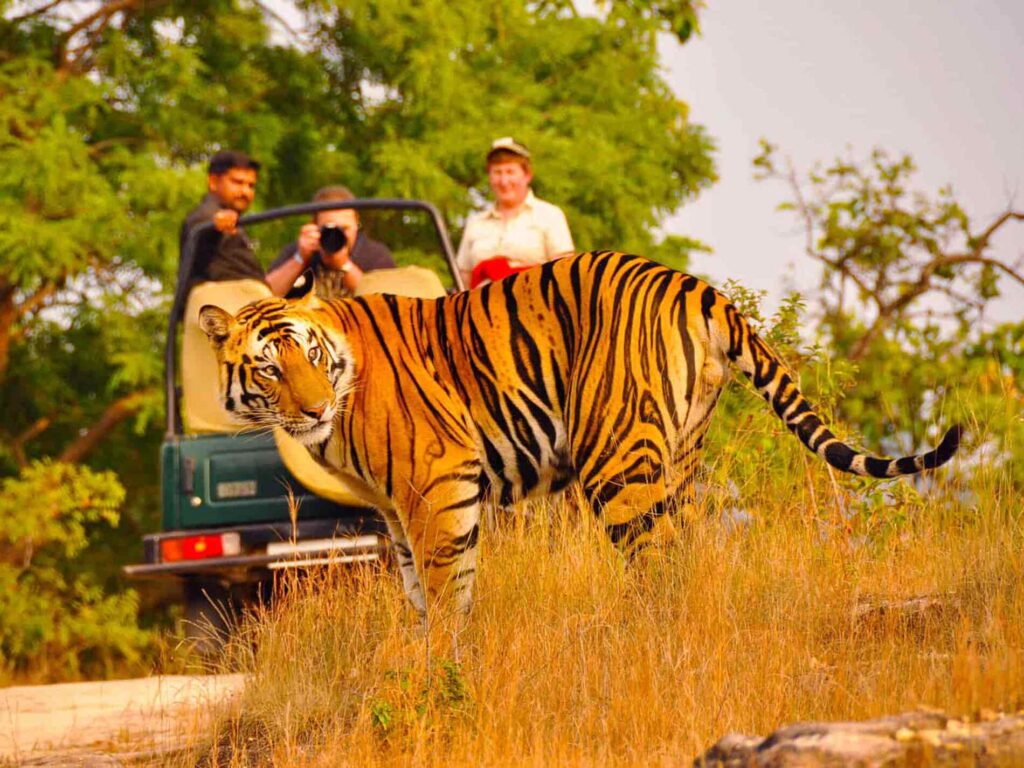Todgarh Raoli Wildlife Refuge: A Sanctuary for Wildlife and Nature Enthusiasts
Snuggled in the Aravalli Range, the Todgarh Raoli Wildlife Refuge is a hidden treasure in Rajasthan that offers a special mix of varied flora and fauna, stunning landscapes, and a rich cultural backdrop. Spanning approximately 495 square kilometers across the districts of Ajmer, Pali, and Rajsamand, this sanctuary is a haven for wildlife fanatics, trekkers, and anyone seeking to escape the hustle and bustle of city life.
A Glimpse into the Refuge’s History
The Todgarh Raoli Wildlife Refuge, named after Colonel James Tod, a British officer who chronicled Rajasthan’s history, was established in 1983. The sanctuary encompasses the ancient Raoli forest, home to numerous indigenous tribes who have coexisted harmoniously with nature for centuries. Their traditional knowledge and customs are integral to the refuge’s ecosystem management, ensuring the preservation of its pristine beauty.
Biodiversity at Its Finest
Flora: The refuge’s varied topography supports a rich diversity of plant life. It is characterized by dry deciduous forests, with prominent species such as teak, bamboo, and dhok trees. The forest canopy is interspersed with flowering plants like kachnar (Bauhinia variegata), palash (Butea monosperma), and the vibrant flame of the forest, which add a splash of color to the greenery, especially during the blooming season.
Fauna: The Todgarh Raoli Wildlife Refuge is home to an impressive array of wildlife. It is a crucial habitat for several species, including the elusive leopard, sloth bear, and sambar deer. Birdwatchers can delight in the sight of over 200 bird species, including the grey junglefowl, Indian pitta, and crested serpent eagle. The refuge is also a haven for reptilian life, with a variety of snakes, lizards, and the Indian monitor lizard.
Adventure and Exploration
Trekking and Nature Walks: The sanctuary offers numerous trekking routes and nature trails that cater to both novice and experienced trekkers. These trails, winding through dense forests and open grasslands, provide an excellent opportunity to spot wildlife in their natural habitat. The best time to embark on these treks is during the early morning or late afternoon when the animals are most active.
Wildlife Safari: For those looking to explore the refuge with a bit of comfort, guided jeep safaris are available. These safaris offer a chance to cover more ground and increase the likelihood of spotting some of the refuge’s more elusive residents, such as the leopard and sloth bear. Knowledgeable guides accompany visitors, providing insights into the sanctuary’s ecosystem and the behaviors of its inhabitants.
Birdwatching: With its rich avian diversity, the refuge is a paradise for birdwatchers. Early mornings are the best time to indulge in birdwatching, as the birds are most active during this time. Visitors can spot species like the white-bellied drongo, Asian paradise flycatcher, and various species of kingfishers and woodpeckers.
Cultural Insights
The sanctuary is not just about wildlife; it also offers a glimpse into the rich cultural heritage of Rajasthan. Several indigenous communities reside within and around the refuge, including the Bhil and Garasia tribes. These communities are known for their vibrant culture, traditional music, dance, and art. Interacting with these tribes provides visitors with a unique cultural experience and a deeper understanding of their way of life.
Conservation Efforts
The Todgarh Raoli Wildlife Refuge is a protected area under the Wildlife Protection Act of 1972. The sanctuary’s management focuses on preserving its biodiversity while promoting sustainable tourism. Various initiatives are in place to protect endangered species and their habitats, reduce human-wildlife conflict, and involve local communities in conservation efforts.
The refuge also serves as an important watershed area, ensuring the availability of water for surrounding regions. Efforts are made to maintain the ecological balance and prevent activities that could harm the environment, such as deforestation, poaching, and overgrazing.
Best Time to Visit
The ideal time to visit the Todgarh Raoli Wildlife Refuge is between October and March when the weather is pleasant and conducive to outdoor activities. The monsoon season (July to September) also offers a unique experience as the refuge turns lush green, and the waterfalls within its confines come alive.
Accommodation and Facilities
While the refuge is a remote area, there are several accommodation options available nearby, ranging from basic forest rest houses to more comfortable hotels and resorts. These accommodations provide essential amenities and services, ensuring a comfortable stay for visitors.
For those seeking a more immersive experience, camping is also an option. There are designated camping sites within the sanctuary, where visitors can set up tents and enjoy a night under the stars, surrounded by the sounds of the forest.
Getting There
The Todgarh Raoli Wildlife Refuge is well-connected by road and can be easily accessed from major cities in Rajasthan. The nearest airport is in Udaipur, about 140 kilometers away, while the closest railway station is in Ajmer, approximately 80 kilometers from the sanctuary. Regular bus services and private taxis are available from these cities to the sanctuary.
Conclusion
The Todgarh Raoli Wildlife Refuge is a must-visit destination for anyone interested in wildlife, nature, and culture. Its unique blend of natural beauty and cultural richness offers an unforgettable experience, making it a perfect getaway for nature lovers and adventure seekers alike. Whether you are trekking through its verdant trails, spotting wildlife on a safari, or learning about the local tribes, the refuge promises an enriching and memorable experience.
For more information and to plan your trip to the Todgarh Raoli Wildlife Refuge, visit Rajasthan Tour Packages.
Q1: Where is the Todgarh Raoli Wild animals Sanctuary located, and what is its significance?
A1: The Todgarh Raoli Wild animals Sanctuary is nestled in the Aravalli Range of Rajasthan, covering around 495 square kilometers across the areas of Ajmer, Pali, and Rajsamand. It is a concealed prize that uses an unique blend of diverse flora and fauna, magnificent landscapes, and a rich cultural backdrop, making it a haven for wildlife enthusiasts, travelers, and those looking for an escape from city life.
Q2: What is the historic value of the Todgarh Raoli Wildlife Refuge?
A2: Established in 1983 and named after Colonel James Tod, a British police officer that chronicled Rajasthan’s history, the haven includes the old Raoli forest. It is home to many indigenous people that have actually coexisted sympathetically with nature for centuries, adding to the sanctuary’s environment management and the preservation of its beautiful beauty.
Q3: What kinds of flora and animals can be found in the Todgarh Raoli Wildlife Refuge?
A3: The sanctuary features completely dry deciduous timberlands with prominent plant varieties such as teak, bamboo, and dhok trees, together with blooming plants like kachnar, palash, and the vibrant fire of the forest. It is home to various wildlife, including evasive leopards, sloth bears, sambar deer, and over 200 bird types such as the grey junglefowl, Indian pitta, and crested serpent eagle. The refuge additionally organizes reptiles, consisting of snakes, lizards, and the Indian monitor lizard.
Q4: What adventure tasks are offered in the Todgarh Raoli Wildlife Sanctuary?
A4: The sanctuary supplies many walking and nature tracks ideal for both beginners and experienced walkers, giving excellent opportunities to identify wild animals. Guided jeep safaris are offered for comfortable expedition, enabling visitors to cover even more ground and possibly experience the sanctuary’s more evasive citizens. The haven’s abundant bird variety additionally makes it a heaven for birdwatchers, particularly in the mornings.
Q5: How does the Todgarh Raoli Wild animals Haven mirror Rajasthan’s cultural heritage?
A5: The sanctuary supplies a glimpse right into Rajasthan’s abundant social heritage with the aboriginal communities, consisting of the Bhil and Garasia tribes, that live within and around the sanctuary. These communities are known for their vivid culture, conventional songs, dancing, and art. Involving with them uses visitors an unique cultural experience and a much deeper understanding of their lifestyle.
Q6: What conservation initiatives remain in place at the Todgarh Raoli Wildlife Sanctuary?
A6: Shielded under the Wildlife Defense Act of 1972, the refuge concentrates on protecting its biodiversity while advertising sustainable tourism. Various efforts remain in location to shield threatened species and their environments, minimize human-wildlife disputes, and include local neighborhoods in preservation efforts. The refuge also serves as a vital watershed location, making certain water availability for bordering regions.
Q7: When is the very best time to check out the Todgarh Raoli Wild Animals Sanctuary, and what accommodations are offered?
A7: The best time to check out the sanctuary is in between October and March when the climate is positive and for exterior tasks. The downpour period from July to September provides a special experience as the sanctuary transforms into a lush eco-friendly haven. Lodging options near the sanctuary array from fundamental woodland remainder residences to comfortable resorts and hotels. Camping is additionally available within the shelter for an extra immersive experience.
Q8: How can visitors access the Todgarh Raoli Wildlife Sanctuary?
A8: The sanctuary is well-connected by road and can be easily accessed from major cities in Rajasthan. The nearby flight terminal is in Udaipur, concerning 140 kilometers away, and the closest railway station remains in Ajmer, around 80 kilometers from the shelter. Routine bus solutions and private taxis are offered from these cities to the sanctuary.



